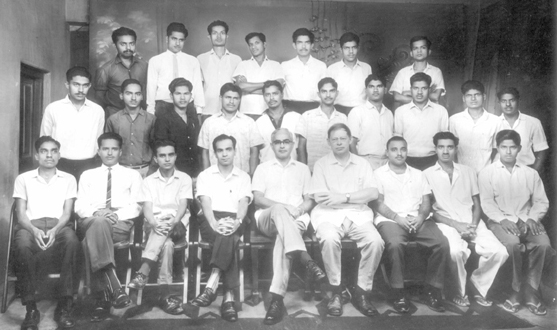3. IN THE WAKE OF KNOWLEDGE
3.6. Milestones in BCG work
3.6.1. Controlled clinical trial for efficacy of BCG vaccine
NTI was also concerned with the efficacy of the BCG vaccine itself. BCG vaccination was the only available protective measure against TB. Different trials had not revealed credible proofs quantifying its efficacy. Many, including late Sri C Rajagopalachari even thought that its efficacy was not fully proven and strongly advocated against its continued large scale use. It would be in the interest of the country to undertake a well designed trial to seek clear answers to the major issues confronting it. Therefore, as stated earlier in Chapter 2, the NTI had been vigorously planning to conduct a major BCG trial and had even reserved certain areas in the country as vaccination free zones. It was in touch with the international scientific community, various vaccine production centres and experts in the field. In January 1964, it initiated intensive discussions with the WHO experts and representatives from United States Public Health Service (USPHS). It was agreed that any trial undertaken must not interfere with the progress of NTI and NTP; and because such a trial was expensive and prolonged, it would have to be designed with utmost care and efficiency.
After extensive discussions, the USPHS agreed to give a grant from the PL480 funds in India. WHO agreed to provide the services of Dr J Guld and some funds. The NTI decided to spare the services of Dr Raj Narain as its first Project Director; experienced field supervisors, investigators and provide other key staff requirements; office accommodation; transport and some equipment so that this important work could begin immediately65. Dr Guld began his regular visits to NTI and started several BCG vaccine and tuberculin related studies: effects of diluents, sterilising agents, ampoule to ampoule variations in the potency of tuberculin dilutions; comparative studies of different antigens and different BCG vaccine strains, etc. Besides Dr Guld, Dr G Weijsmuller and others from USPHS visited the NTI and started several feasibility studies.
|
Feasibility Prevention Trial (Chingleput BCG Trial
Team) |
Ultimately, the project named Feasibility Study for TB Prevention Trials became part of the ICMR and moved out of the campus to its own building65. In time, its studies showed that the major BCG trial would be best if conducted in Chingleput district of Tamil Nadu than in other areas reserved for the purpose. Field work began and the office was moved to Madras. In spite of shifting of the project camp to Madras, NTI continued to assist the BCG Trial by providing technical guidance and replacement of staff. When Dr Raj Narain retired, Dr Baily joined as the Director of this study and continued to serve till the first report was published66.
The BCG trial was completed as scheduled. After a period of twelve and a half years, it brought out a revolutionary report. It showed that BCG vaccination did not offer any protection against TB of the lung. Several expert committees appointed both by the authorities in India and by the WHO examined all the procedures followed up in the study and came to the conclusion that the study had been meticulously carried out and vaccine used in the trial were the best available ones66. The implications of this study was: Should BCG vaccination be given up in India? Another committee appointed jointly by ICMR and the WHO went into the epidemiological aspects of the causation of TB under Indian conditions. It concluded that though BCG may not protect against TB of lung which occurs mostly in adults, it could provide substantial protection against childhood forms of TB such as tubercular meningitis, TB of bones and joints, etc. The protective effect of BCG against these forms of TB was not studied in Chingleput Trial. In India BCG vaccination policy was revised and it was recommended to be given at an early age preferably before the end of the first year after birth by integrating under UIP67. BCG vaccination policies in other countries were also revised as a consequence of the Chingleput study findings.
